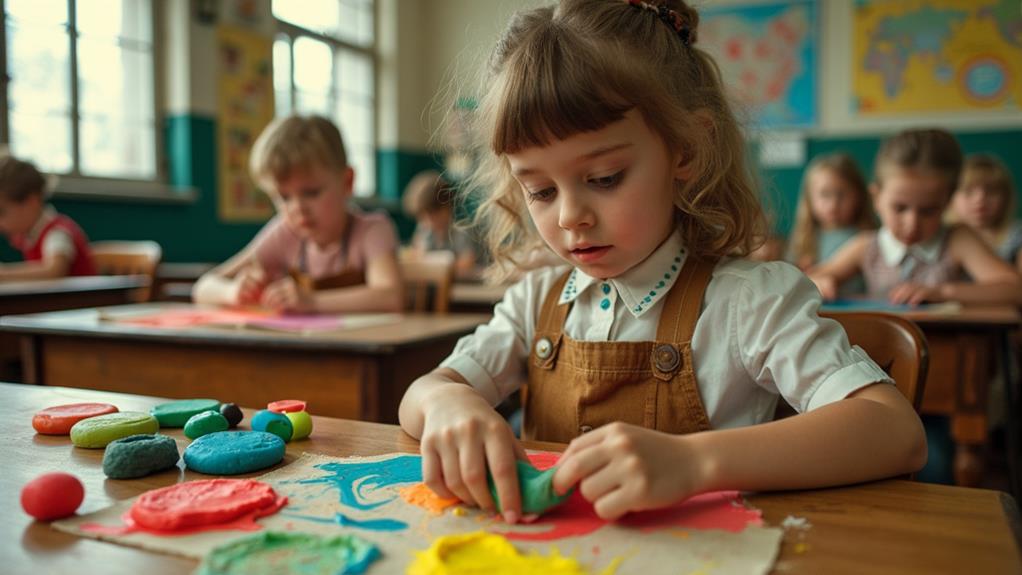What Was the Original Purpose of Playdough?

You might be surprised to learn that Play-Doh wasn't originally intended as a toy for children. In fact, its initial purpose had nothing to do with playtime. Invented in the 1930s by Noah McVicker for Kutol Products, this versatile compound was created to clean wallpaper by removing coal soot. After World War II, when demand for wallpaper cleaner declined, it found a new life in children's arts and crafts. Want to know how this transformation happened and why Play-Doh became a household name? There's more to this story than meets the eye.
History of Playdough

Play-Doh didn't start out as the beloved children's toy it is today. In fact, it was originally developed in the 1930s by Noah McVicker for Kutol Products as a wallpaper cleaner. The product was designed to remove coal soot from walls, a common issue in homes heated by coal. However, after World War II, the demand for wallpaper cleaner declined as coal heating became less common.
Kay Zufall, a nursery school teacher, saw potential in the declining product. She suggested repurposing it for children's arts and crafts, leading to a safer reformulation suitable for children. Joseph McVicker, Noah's nephew, recognized the opportunity and took the idea further. In 1956, he rebranded the cleaner as Play-Doh and established the Rainbow Crafts Company to market it as a children's modeling compound.
The history of Play-Doh took a significant turn when it was showcased at educational conventions and featured on children's television shows. This exposure rapidly increased its popularity, transforming it from a simple wallpaper cleaner into the beloved toy that has become a staple in children's arts and crafts activities.
Original Composition
Play-Doh's evolution from a practical wallpaper cleaner to a beloved children's toy highlights the ingenuity behind its original composition. Developed in the 1930s to address coal soot on wallpaper, this product consisted of flour, water, salt, and other ingredients that made it both effective and safe for household use.
The original formulation was non-toxic and malleable, allowing it to be applied to walls without safety risks. It was designed to avoid staining, enabling homeowners to use it on various surfaces confidently. Its non-toxic nature ensured it posed no harm to anyone in the household, including children.
When Play-Doh transitioned to a children's modeling compound, its composition was only slightly modified to enhance playability while maintaining safety. The introduction of different colors and textures followed naturally, solidifying its status as a safe and entertaining product for children. Thus, the original emphasis on non-toxicity and safety was crucial to Play-Doh's lasting success.
Transition to Toy

Despite its origins as a practical wallpaper cleaner, the decline in demand after World War II set the stage for Play-Doh's transformation into a beloved children's toy. Joseph McVicker saw an opportunity to rebrand the non-toxic cleaner as a modeling compound for kids. This transition began in 1956 when McVicker reformulated the product, shifting its purpose from cleaning agent to creative play material.
Kay Zufall, a nursery school teacher, played a pivotal role in this change. She suggested using the compound for arts and crafts after observing its potential in her classroom. This inspired McVicker to target the educational market, recognizing that Play-Doh could be a valuable tool for learning and creativity.
In 1957, McVicker officially launched Play-Doh as a children's toy, initially offering it in three colors: red, yellow, and blue. The product quickly gained popularity, especially due to its presence on children's television shows.
Key points about Play-Doh's evolution:
- Originally a wallpaper cleaner: Designed to remove coal residue.
- Rebranded in 1956: Shifted to a modeling compound for kids.
- Kay Zufall's influence: Suggested its use in arts and crafts.
- Launched in 1957: Became a staple in the educational market.
Marketing Evolution
From its inception, the marketing evolution of Play-Doh was nothing short of ingenious. Originally a wallpaper cleaner in the 1930s, Play-Doh's transformation into a children's modeling compound in the mid-1950s was a masterstroke. Teachers quickly recognized its potential for arts and crafts, leading to a rebranding that catapulted the product to new heights.
Targeted advertising played a crucial role in Play-Doh's success. By the late 1950s, commercials on children's television shows like Captain Kangaroo captivated young audiences, causing sales to skyrocket as more children and parents became aware of the product.
Play-Doh's availability in major department stores by 1958 further amplified its visibility and accessibility. Aggressive marketing strategies in the 1960s, including themed sets and educational promotions, solidified Play-Doh's place in the hearts of children everywhere. These strategies were not just about selling a product; they were about creating a trusted experience for parents and educators.
Cultural Impact

Play-Doh's cultural impact is undeniable, evolving from a simple wallpaper cleaner to a beloved childhood staple. Initially developed in the 1930s, this children's modeling compound found new life in the 1950s through clever rebranding and marketing. Endorsements from Bob Keeshan on "Captain Kangaroo" skyrocketed its popularity, embedding Play-Doh into the fabric of childhood entertainment.
By 2005, over two billion cans had been sold worldwide, underscoring its universal appeal and cultural significance. Here are key reasons why Play-Doh has left an indelible mark:
- Creativity and Imaginative Play: Play-Doh fosters both, allowing kids to mold and shape their ideas into tangible forms.
- Educational Value: It's often used in classrooms to improve fine motor skills and teach concepts like shapes and colors.
- National Toy Hall of Fame: Inducted in 1998, Play-Doh is celebrated as an iconic toy that has spanned generations.
- Nostalgic Smell: Its unique scent has become a hallmark of childhood, even leading to a trademarked perfume for its 50th anniversary.
Play-Doh's transformation from wallpaper cleaner to an educational and creative powerhouse illustrates its profound cultural impact.




